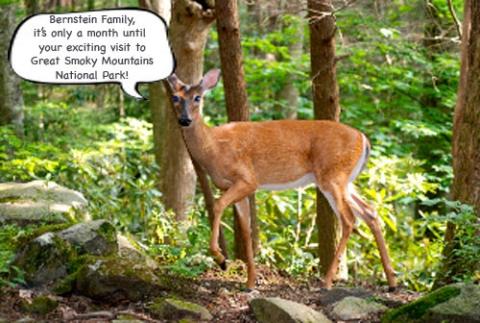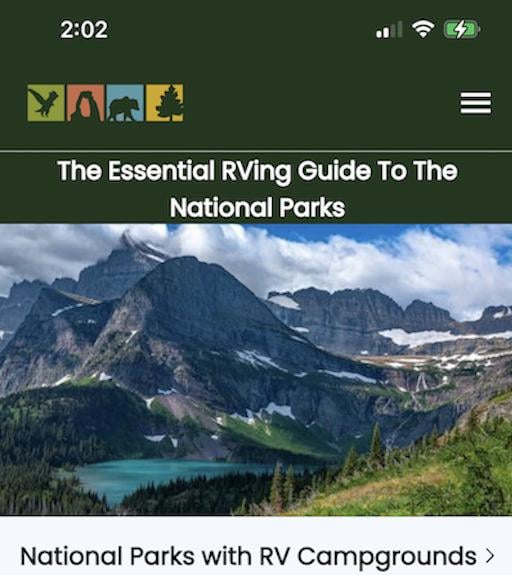Editor's note: The National Park Service is prohibited from advertising the 392 units of the National Park System, which might be both a good and a bad restriction. Guest writer Danny Bernstein imagines in the following column what things might be like if the Park Service could advertise the parks in a fashion similar to theme parks.
This past holiday season, my family went to DisneyWorld.
Our son hasn't been to DisneyWorld since he was in grade school, and now he's a father of two. I made reservations to stay at the resort, got tickets for the various theme parks, and I thought my trip planning was finished. Instead, I got a steady stream of marketing e-mails, from the time I booked, almost daily through December.
Since I spend a lot of time in Great Smoky Mountains National Park and on the Blue Ridge Parkway, I got to thinking: What if our national parks marketed themselves like DisneyWorld?
Two months before your visit, you'd get an e-mail:
“Are you getting ready for your visit to the Smokies? Planning to enjoy the climb up to Mount Sterling on Baxter Creek Trail? Sign up for your Smokies fitness classes now. Learn about a Great Smoky Mountains National Park vacation from a very special panel of advisers — everyday hikers and visitors who've been to the park often.”
A month before:
“Bernstein family, it's only a month until your exciting visit to Great Smoky Mountains National Park! By now you should have bought your hiking boots and pack. Break in your boots and get your gear together. No hills where you live? Climb several flights of stairs at your school or office to simulate climbing to Gregory Bald.”
Three weeks before, you open a message with a huge picture of Smokey Bear:
“Dear Bernsteins, I see you're coming with your adorable 6-year-old. She would love to have lunch with Smokey Bear. Sign up now for a delicious lunch of peanut butter and jelly on 100 percent whole wheat bread, an apple and our special trail mix (Trademarked). Bring a water bottle. Remember, reservations are limited.”
Ten days before your trip, the e-mail message arrives flagged as high priority:
“You've reserved two campsites at Smokemont Campground. We highly recommend that you check in online and avoid waiting in line. This will give you more time to spend exploring the park.”
So you check in online and you read the terms and conditions that apply to your stay in the Smokies. You find that you agree not to harass the wildlife, leave food out on your picnic table, or take your dog on backcountry trails. You've also agreed not to pull out plants, leave litter on the trail or roads and be very careful when you put out a campfire.
Three days and counting:
“Wow! Only a few more days to go until you're celebrating the magic of your Great Smoky Mountains National Park visit. Consider bringing back Trails of the Smokies, your guide to every trail in the park so you can plan your next Smokies vacations. Smokies stores are conveniently placed throughout the park.
“And by the way, plan to keep checking your e-mail throughout your stay for more tips.”
OK, so you can't get cellphone service in the Smokies, and certainly not Wi-Fi. And the national parks by law can't advertise. We don’t think that national parks should model themselves after amusement parks, but some well-placed ads touting the spectacular scenery, rich cultural and historical landscapes, and recreational and educational opportunities could bolster recognition of, support for, and enjoyment of the national parks. Maybe more visitors would then be prepared to get out of their cars and onto the trails.




Comments
I agree with your last paragraph. The national parks could use some advertising but with careful consideration of the content. The parks belong to everyone and I enjoy visiting the parks with people who respect the environment and wildlife. I don't want them overrun by people expecting a Disney type experience.
Although advertising for the National Parks could attract a lot of people who would have a debatable effect on the parks, with people expecting a Disney type experience, planning a trip would most likely be a lot easier. I think comparing the marketing to Disney is an exaggeration as this would be a turn off for most of the audience and the park service simply doesn't have the budget for that sort of effort.
Trying to plan backpacking trips this summer for Yosemite and Grand Teton has been a headache as nps.gov lacks consistent planning tools from park to park and vague information at best. A good interactive ad agency would be able to build out some strong, consistent trip planning tools to give potential visitors the info they need for an enjoyable trip in the back or front country.
I think some of the same agencies that handle some of the outdoor brands could handle the responsibility in a tasteful and respectful manner for the parks and avoid a Disney feel.
People already treat the wildlife in the park like it's a petting zoo - getting too close for the perfect picture. If they market them like a theme park, people will treat it as such! They're National Treasures, not fantasy land.
The NPS uses media releases and media interviews like real pros. The Ken Burns series was about as good an ad for the NPS as possible given the restrictions.
However - if someone has a campground or lodging reservation, what's to keep the NRRS or the concessionaire from sending out email alerts in the fashion described? Perhaps it doesn't have to be filled with exclamation points, but simple information points wouldn't seem to be against NPS policy.
I believe that the National Parks are not designed to handle the tourist traffic that Disneyworld was "constructed" to handle. Don't get me wrong, I love visiting the Disney Parks and Resorts but they are, for the most part, man-made and can be maintained and repaired in ways that many National Parks cannot. In addition, my observation of many people is that most do not respect the places they are visiting. They litter and don't respect the places they are visiting. This would have a destructive effect on the National Parks. I have visited 5 National Parks over the past 3 years and feel that those of us who partake of the hiking and other outdoor activities in the Parks are more aware of the "footprint" left. As we say, "leave no trace".
I can't think that even with advertisement that any NPS setting is going to get the concentrated foot traffic of an amusement park.
Even in well known "zoos" like Yosemite or Yellowstone, it's possible to find places of solitude by taking fairly short foot trails. About the only place in a National Park that I've seen that comes close to approaching a Disney park is the crowds surrounding Old Faithful. Even that isn't too bad.
And for real irony, there is the new Walt Disney Family Museum on NPS property.
http://disney.go.com/disneyatoz/familymuseum/index.html
No. The National Parks are too majestic and dignified to be cheapened by advertising such as this. The money would be more well spent on the NPS budget of managing and preserving the Parks.
Fifteen years ago I proposed a marketing concept to senior management in a regional office and was met with the abrupt response, "Marketing! We don't need marketing, we've got more than enough visitors already." I would hope over the years, NPS management has both learned the definition of marketing and developed an understanding of how it could aid the Service in managing its visitors/guests. We could probably learn something from a recreation-based company that attracted over 67.6 million paid visits (2008) to its domestic properties. Fortunately, the Service has acknowledged Disney as a leading source in several areas of mutual concern, including people moving, exhibits, orientation and training and more. Sadly, "marketing" is still a dirty word for many Service employees and they retain a negative view of The Disney Company - makes a profit, destroys/pollutes the environment, promotes "fake" experiences. This clouds their ability to see the organization as a source of highly effective visitor/guest management strategies and tactics. That said, there's no reason why the vast array of park partners, especially organizations like the membership of the Association of Partners for Public Lands (APPL), could not take on the responsibility of "building" marketing as a means of enhancing both visitor experience and resource protection. Much of what they already do bears a marketing stamp. If Service leadership would show some interest in a long-term program, I'm sure APPL would respond.
Frankly, I think it would be wonderful to see NPS "advertising" of the quality shown in commercials for our armed services. The recent series released by the U. S. Marine Corps is especially attractive if not downright patriot-building. Between Harpers Ferry Center and their film contractors, I could see some dazzling spots for the agency, its mission, and even messages like "leave no trace." Both macro and micro-marketing could be such a powerful constituent builder for the national parks. Go for it.